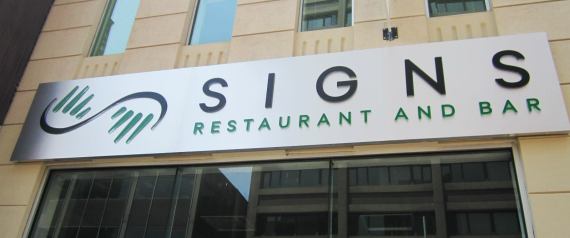How about going to a restaurant only to have your orders fall into deaf ears? No, it’s not a figure of speech but literally into deaf ears. Imagine using sign language to order your dishes !! Actually, not a bad thing at all if you go by what customers are experiencing. The entire dining experience has been redefined in a new restaurant that just opened up in Toronto’s Younge Street.
Anjan Manikumar, the brainchild behind this idea, is an entrepreneur and an innovative restaurateur, who has spent nearly a decade in the restaurant industry. Starting at the early age of 17, Anjan worked his way to the position of Restaurant General Manager / Area Manager handling three restaurants at one time. He had been employed in all types of restaurants dealing with fast foods, casual dining & fine dining. In the process, over the years, he accumulated enough experience to manage any type of restaurant.
The inspiration for “Signs”
This dates back to the time when Anjan was working as a manager in a Pizza restaurant. One of the most regular customers there was hearing impaired. Whenever that customer had to order, it was a routine of “point, nod and serve” recalls Anjan. However, this experience inspired Anjan to learn the American Sign Language (ASL) in order to communicate with his customers. “I felt he wasn’t getting the service he deserved,” says Manikumar. “He wasn’t getting the personal touch.”
Anjan talking to his father and principal investor, Manny Manikumar in sign language.
From that moment of prime customer service came the idea for a new Restaurant, where the deaf can work and dine using their language. It was also to be a place for the hearing to learn about the deaf community. It was an attempt to teach the curious diners about the challenges the non-hearing community faces on a daily basis.
Sign Language at Signs
In July 2014, Anjan opened up his novel restaurant very appropriately called “Signs”. All the servers here are deaf. “Noise meets Silence” is the theme for this restaurant and customers are encouraged to order using a sign language. The menu here doesn’t just have the name of the dishes, but even the “sign” that the customer has to use to order that dish. There is a “cheat book” that illustrates what signs the customers need to use to order a particular dish.
So if you need a chicken salad at Signs, use your index finger and thumb to chomp once like a beak, and toss a salad with both hands. In the mood for a rabbit? Turn your hands inward against your temples and flap two fingers like bunny ears.
This redefined dining experience is sure going to be entertaining. But Signs is really more than that. In 2006, Canada had reported an unemployment rate of 10.4 per cent for those with “hearing limitations,” a broad category. The number is estimated to be much higher for the completely deaf. Little research has been done since on deaf employment. Anjan Manikumar has clearly embarked on a kind of community service for a deaf population that often struggles to find employment in a speech-oriented workforce. The restaurant hopes to help an underemployed segment of the population.
Manikumar says that when they first posted for a position of a deaf wait staff they were inundated with hundreds of responses. “I hope this encourages people in other sectors to hire deaf people as well,” says Manikumar.
For the records, Signs isn’t the first restaurant of this kind — San Francisco is already home to Mozzeria, a pizza restaurant with deaf owners and staff. Signs is a first in Canada to have a large deaf serving staff and the first to fully integrate sign language into the dining experience. When guests arrive they are greeted by a hearing hostess who acts as a translator as guests are introduced to their deaf server. Once seated, the “cheat book” of ASL illustrations help the guests communicate with their server. Pointing is allowed — if absolutely necessary.
Lastly,
It’s always good when entrepreneurs can center their business around community service too. And “Signs” is a perfect demonstration of that.
“I think this is one of the largest breakthroughs we’ve seen in our community in a long time,” says Anjan Manikumar. .
